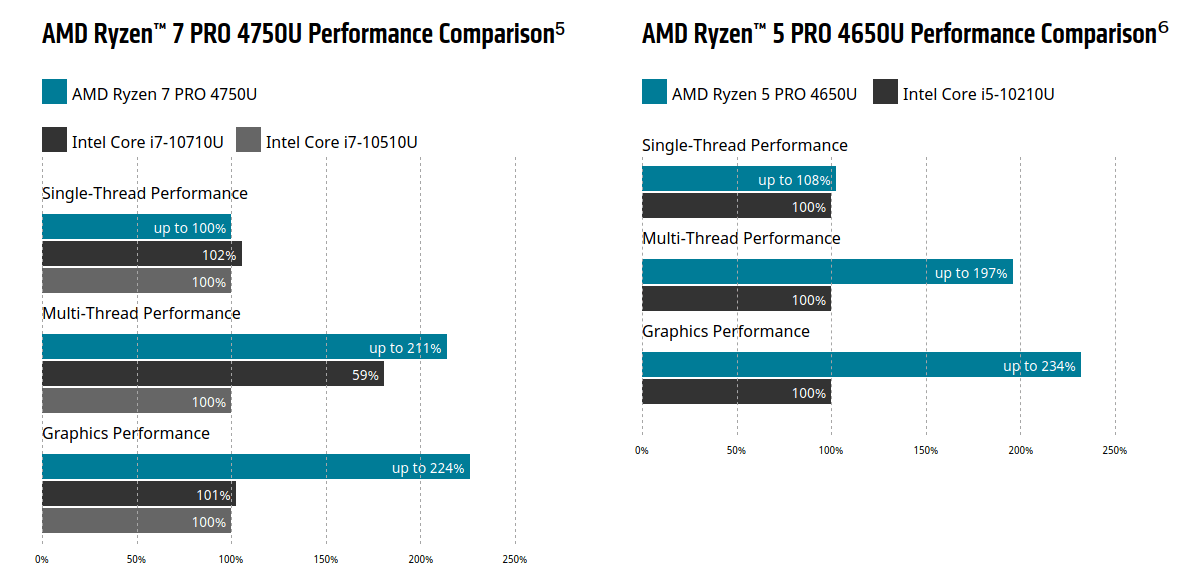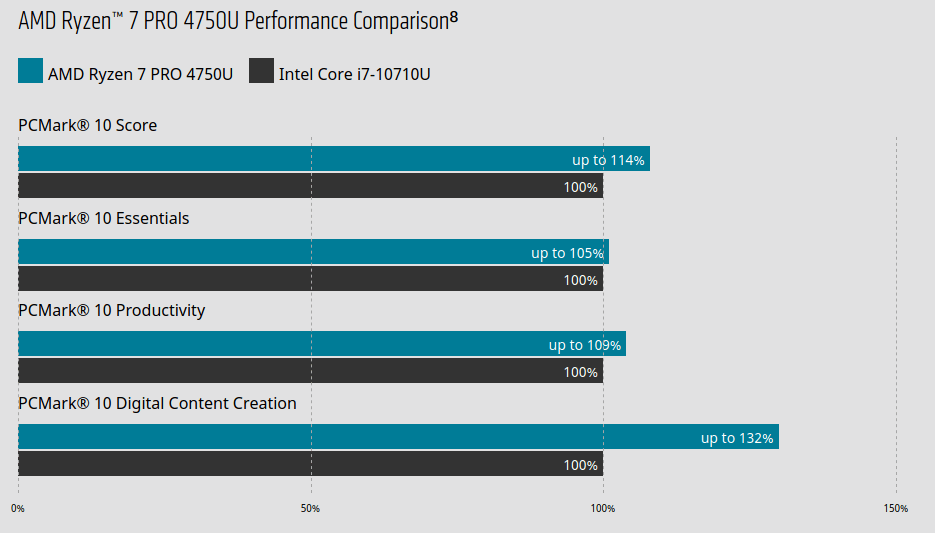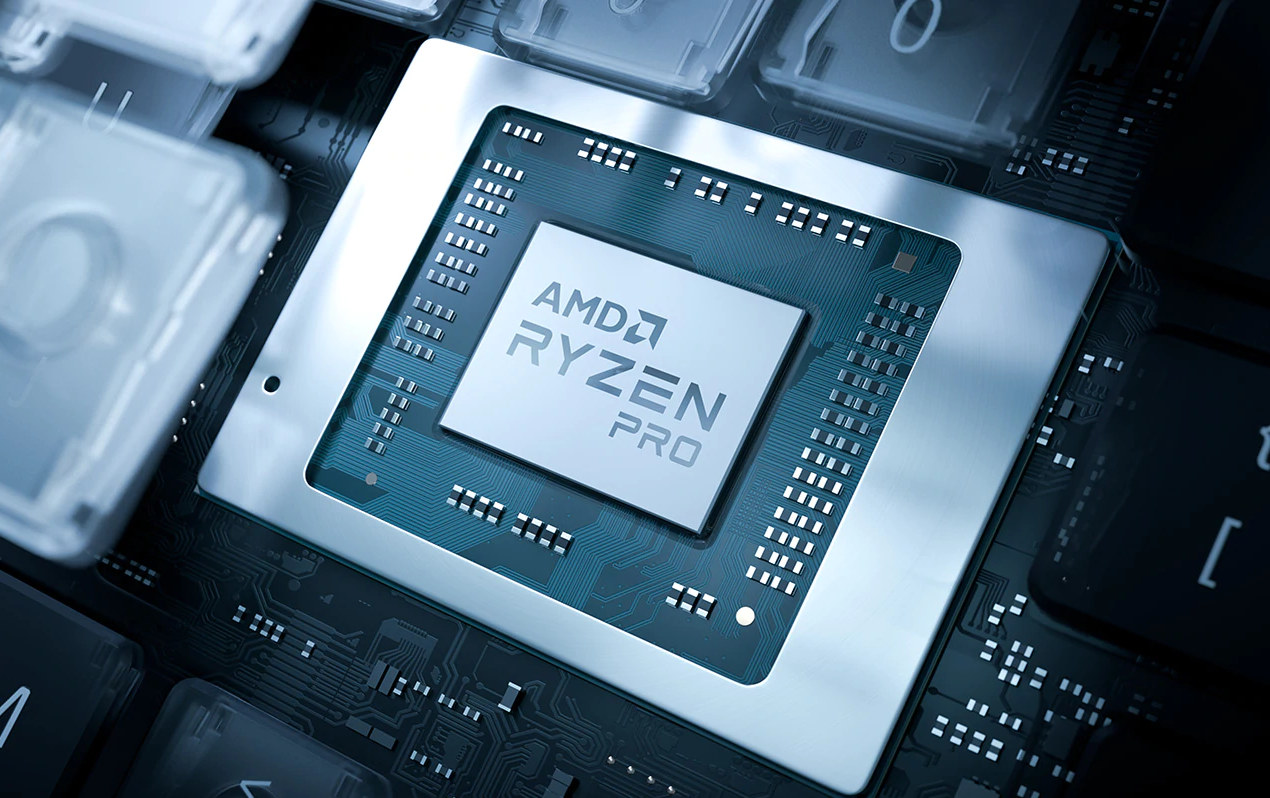AMD announced 15W to 45W mobile processors at CES 2020 with AMD Ryzen 4000-U series processors designed for ultra-thin laptops. The company has now unveiled AMD Ryzen PRO 4000 series mobile processors for business customers requiring features usually found in Intel vPro processor with AMD PRO Technologies including improved security, manageability, reliability, and longevity with at least 24-months of planned availability.
Three AMD Ryzen PRO 4000 processors have been launched all with 15W TDP (configurable between 10W and 25W):
- AMD Ryzen 7 PRO 4750U octa-core/16-thread processor @ 1.7 GHz / 4.1 GHz (Turbo single core) with 7 Radeon GPU cores, 12MB L2/L3 cache
- AMD Ryzen 5 PRO 4650U hexa-core/12-thread processor @ 2.1 GHz / 4.0 GHz with 6 Radeon GPU cores, 11 MB L2/L3 cache
- AMD Ryzen 3 PRO 4450U quad-core/octa-thread processor @ 2.5 GHz / 3.7 GHz with 5 Radeon GPU cores, 6MB L2/L3 cache
The processors are also said to be the first world’s first x86 7nm commercial notebook processors being manufactured with a TSMC 7nm FinFET process.
AMD pitted its new processors against 15W(non-vPro) Intel Comet Lake processors namely AMD Ryzen 7 PRO 4750U against Intel Core i7-10510U/i7-10710U, and AMD Ryzen 5 PRO 4650U against Intel Core i5-10210U processor showing similar single-thread performance, but much better multi-thread performance due to the higher number of cores.

PCMark 10 benchmarks show AMD Ryzen 7 PRO 4750U to be faster than Intel Core i7-10710U in all workloads, but especially digital content creation where multi-thread performance is more important.

AMD Ryzen PRO 4000 powered enterprise laptops from HP and Lenovo are expected in the first half of 2020. Further information may be found on the product page and press release.

Jean-Luc started CNX Software in 2010 as a part-time endeavor, before quitting his job as a software engineering manager, and starting to write daily news, and reviews full time later in 2011.
Support CNX Software! Donate via cryptocurrencies, become a Patron on Patreon, or purchase goods on Amazon or Aliexpress. We also use affiliate links in articles to earn commissions if you make a purchase after clicking on those links.






Multi-thread difference on such CPUs doesn’t solely depend on the number of cores; actually the frequency range is huge (1.7 to 4.1) and you can easily achieve higher performance with less cores at more than twice the frequency. What matters the most to performance here is the highet frequency reached with the *workload*’s cores in use. This means, top all-core frequency for some highly parallel workloads (make -j for me), and top frequency on one core when only 1-2 others are moderately used (browsers, editors etc).
Also, AMD’s “threads” are a bit more than just threads in that they each have a few dedicated parts like simple ALU ports IIRC while intel shares everything. So theorically you have to expect a higher thread-to-core perf ratio on AMD, which may also count for the reported multi-threaded gains over their competitor.
Last, there’s no comparison on battery longevity. Because we already know how fast it drains with one core at full frequency (in part because it requires to increase the voltage on all cores). L3 cache counts a lot as well as it avoids accessing highly power-demanding RAM, and in some cases a CPU with twice the L3 and slower RAM could get higher performance and lower power drain. The press releases mentions a target to 20+ hours of barrery but that doesn’t mean anything as it depends on the laptop’s capacity. My thinkpad with its 8th gen i7 lasts many hours thanks to a 57Wh battery. Could I get even more with a ryzen inside, nobody knows yet.
Zen 2 IPC + 7nm can do wonders in terms of performance and lower power consumption…
I have the 3200U and i experiment broken “suspend to ram” even with linux kernel 5.4, if someone know a secret 😉
However this CPU + APU is really impressive in terms of computation speed and power consumption (very easy 5hours web, vlc and 46wh battery)
Usually broken suspend to RAM is a BIOS issue, you need to check the vendor’s site for upgrades. I’ve had machines where it never worked, or would never wake up, but the latest ones are OK (eeepc 1005HA, Thinkpads t430s and t480s).
Is Intel ever going to have a comparable integrated GPU?
I don’t understand why AMD always dominates Intel in this space.
AMD is more represented among gamers and intel being legacy is more represented in enterprise. There’s of course quite some overlap between the two but there’s enough captive market for each of them that they can avoid stepping on each other’s toes. I *personally* prefer to have an integrated low-power VGA-like graphics controller than something which increases temperature or drains my battery for no purpose. I suspect the graphics controller in my 8th gen i7 supports some 3D stuff, but what’s certain is that these instructions will never have a chance to be woken up there.
Beyond the actual performance of the APU (compute and graphics), multithreading and power consumption the keywords here are: AMD PRO security, AMD PRO manageability and AMD PRO business ready.
These are the things that will get them passed the corporate IT department for approval. Without these things and even with a clear win against Intel, IT would not even look at it. Corporate users are computing Barbarians, even worse than teenage gamers. So when you have several thousands of them in a company the IT people want to be able to manage all their laptops remotely: lock everything that can be locked, push forced updates, etc. They also want to be able to continue buying these models for several years so that they do not have to redesign the IT processes each year.
These Pro chips are for corporate consumption, as an individual there would be no reason to use any of the Pro features.